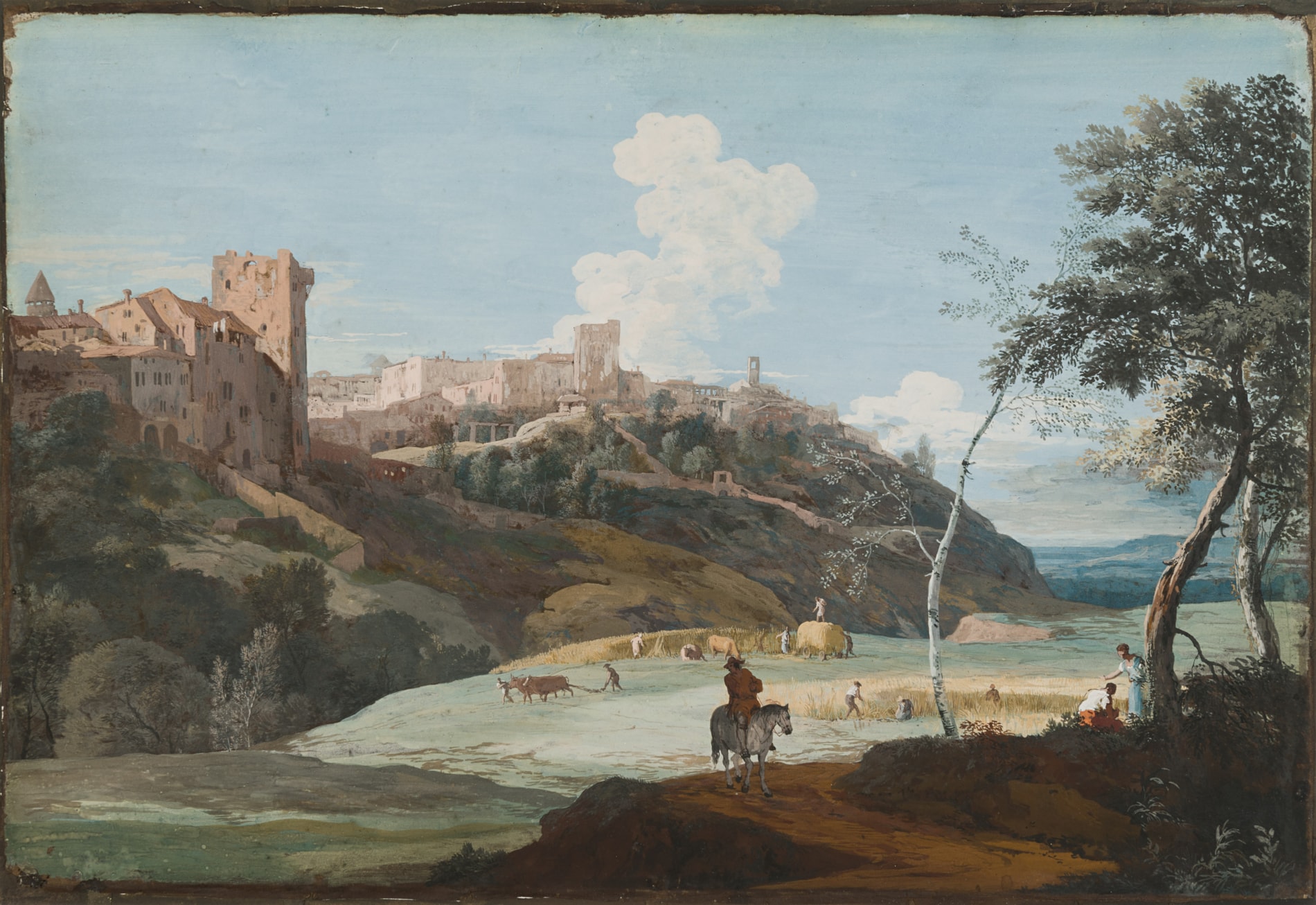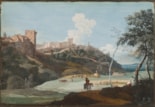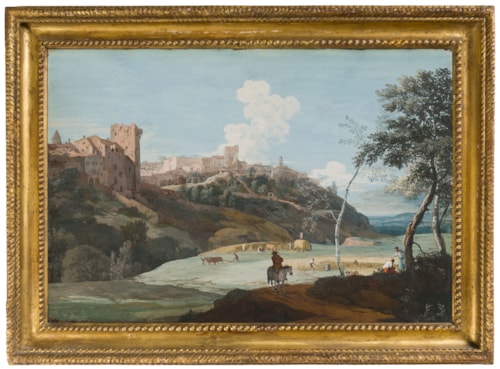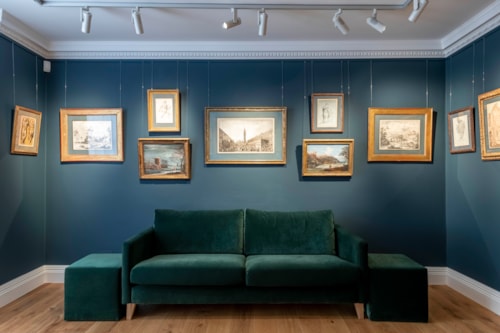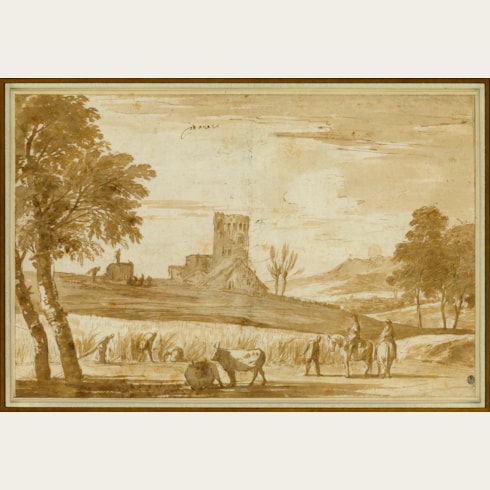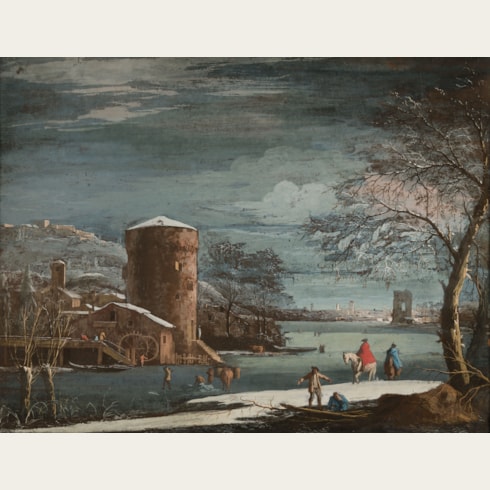Marco RICCI
(Belluno 1676 - Venice 1730)
Summer Landscape with an Italian Hill Town and Grain Harvesters
Tempera on kidskin, laid down on card.
300 x 450 mm. (11 3/4 x 17 3/4 in.)
300 x 450 mm. (11 3/4 x 17 3/4 in.)
The present sheet is a fine and fresh example of a genre that Marco Ricci made his particular specialty. Indeed, the artist appears to have produced as many gouache landscapes, painted on kidskin (and, only occasionally, on paper), as he did larger-scale works in oil. These picturesque and brightly coloured landscapes were intended to be framed and displayed as small paintings. Aptly described by Michael Levey as ‘atmospherically subtle, small scenes of the north Italian countryside, invested with such a direct eye for nature that Corot might have envied it’, Ricci’s gouache landscapes often display distinct echoes of the countryside around the artist’s native hill town of Belluno, in the eastern Dolomites. Some 130 of these gouache landscapes are known today, almost a quarter of which are at Windsor Castle.
Another gouache landscape depicting a grain harvest, different in composition, is in a private collection in Italy, while a similar subject is also found in a gouache drawing formerly in a private collection in London.
Another gouache landscape depicting a grain harvest, different in composition, is in a private collection in Italy, while a similar subject is also found in a gouache drawing formerly in a private collection in London.
Marco Ricci received his artistic training in the studio of his uncle Sebastiano Ricci, with whom he often later collaborated. A landscape painter first and foremost, he completed the landscape backgrounds in Sebastiano’s canvases, and is also known to have assisted other artists, including the Genoese painter Alessandro Magnasco. Marco Ricci worked initially in Venice, although he fled the city in the late 1690s after killing a gondolier in a tavern brawl, apparently by breaking a jug over his head. He returned to Venice in the early years of the 18th century, and later worked in Florence and Rome. He also developed a reputation as a theatrical painter, working in this field in Venice and London. In the autumn of 1708, at the invitation of the British ambassador in Venice, Charles Montagu, 4th Earl (later Duke) of Manchester, Ricci made the first of two trips to England. He worked alongside Giovanni Antonio Pellegrini on the decoration of Burlington House in London, Kimbolton Castle in Cambridgeshire and Castle Howard in Yorkshire, and also designed scenery for the Italian Opera at the King’s Theatre, Haymarket. He left England in 1710 but returned for a second time with Sebastiano in 1712, remaining there until 1716 before returning to settle in Venice. Together with his uncle and several other prominent artists, Ricci was commissioned by the entrepreneur Owen McSwiny to paint a series of allegorical tombs dedicated to prominent English noblemen; his Monument to the Duke of Devonshire was completed in 1725. In many of his paintings, gouaches and drawings can be seen the particular influence of the Dutch and Flemish landscape tradition of the previous century. Furthermore, as one recent scholar has noted, ‘Evidently Ricci was prepared to try his hand at different styles and techniques. He was receptive to varying landscape styles, agreeable to collaborative efforts, willing to produce different types of imagery, and capable of painting pastorals or storms, delapidated ruins or busy little towns, in either oils or tempera.’ Perhaps encouraged by the connoisseur and publisher Anton Maria Zanetti, Ricci took up printmaking around 1723. Some thirty-three etchings by him are known, twenty of which were included in the series Varia Marci Ricci Pictoris Praestantissimi Experimenta, published by Carlo Orsolini in Venice in 1730, the year of the artist’s death.
As a draughtsman, Marco Ricci is best known for his landscapes drawn in pen and ink, as well as for the distinctive gouache landscapes that he had begun to produce by the time of his second visit to England in 1712, and which appear to have been his invention. Two large collections of Ricci’s drawings were formed in his lifetime; that of Zanetti, who owned 141 drawings by the artist mounted into an album, now dispersed, as well as a large number of gouache landscapes, and that of Consul Joseph Smith, whose collection of 146 drawings, 32 gouaches and 136 caricatures by Ricci is today in the Royal Collection at Windsor Castle.
Provenance
Anonymous sale, London, Christie’s, 4 July 1984, lot 73
Khalil Rizk, New York
Pierre Durand, New York.
Khalil Rizk, New York
Pierre Durand, New York.

